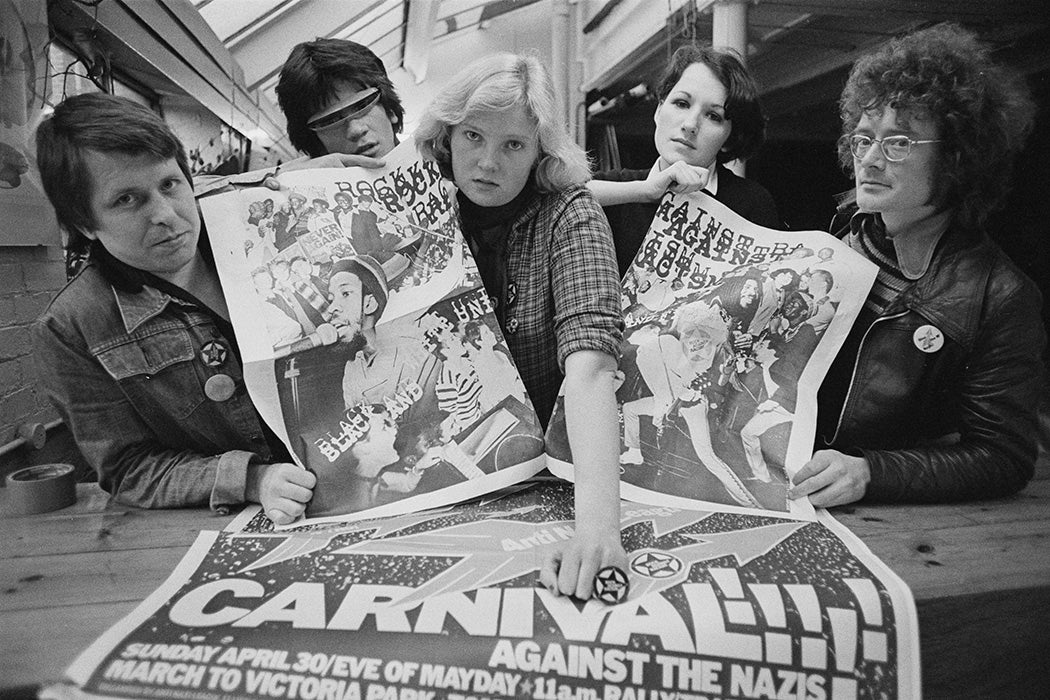With images of Confederate flags and anti-Semitic slogans, the insurrection at the U.S. Capitol not only sparked outrage, it also left many wondering what could be done to stop such violence. The U.S. is hardly the first country to reckon with questions like this. In Britain, for example, the growth of the right led to the creation of Rock Against Racism (RAR), a movement against the rising tide of white supremacist violence, in 1976.
The fires had been stoked for years. British politician Enoch Powell, for example, had been steadily adding to the fuel with speeches warning of invading immigrants and a growing nonwhite population. In a 1968 speech, as historian Amy Whipple writes, he warned that “the postwar influx of immigrants from the former colonies in the West Indies, Southeast Asia, and Africa made the native English ‘strangers in their own land.'” This address, popularly known as the “rivers of blood” speech, “elicited both acclaim and criticism across Britain.”
The right-wing movement grew, historian Evan Smith explains, “increasing its public presence through provocative street marches and confrontations with antifascist protestors, the police, and Britain’s black communities. This push to occupy the streets was combined with a campaign of intimidation, which saw a dramatic increase in violent attacks on Britain’s black communities.” When rhetoric like Powell’s was given an even bigger stage in August 1976 with a racist rant by Eric Clapton (“I used to be into dope, now I’m into racism”) during a concert at the Birmingham Odeon, activists wanted to fight back.
Founded by a group of artists and activists, many working for the Socialist Worker, Rock Against Racism knew from the beginning that “there were bigger fish to fry than one one hypocritical rock star,” but used the incident as a catalyst for organizing.
In a letter sent to several magazines, the group wrote of its opposition to the “racist poison in rock music” and stood in the belief that rock could be a “progressive culture.” With a dual mission to speak out against racism and fight against far-right political parties like the National Front, RAR organized around the punk and reggae scenes, as both were gaining popularity with British youth. As Smith explains, “although this music was characterized as radical and confrontational, it was not inherently progressive or leftist, and the National Front attempted to recruit the white youth attracted to punk.”
Weekly Newsletter
RAR, alongside the Anti-Nazi League, organized a series of carnivals featuring punk and reggae acts like X-Ray Spex, the Clash, and Steel Pulse across the country, aimed at bringing together music fans of all races. Through their series of local events (more than 300 in 1978–79), RAR and the Anti-Nazi League were, Smith writes, “largely successful in publicizing the Nazi elements of the National Front and eroding popular support for them through the massive dissemination of anti-NF propaganda, with 5.25 million leaflets and a million badges and stickers distributed during the first year of ANL’s existence.”
The group dissolved in the early 1980s, but at its height, it was able to engage Britain’s youth in a fight against the country’s increasing racist violence. As Smith writes, the group “highlighted the role that youth culture could have in attracting attention to new social movements and areas of progressive politics,” or as the founders wrote in their manifesto, “Love Music Hate Racism.”







